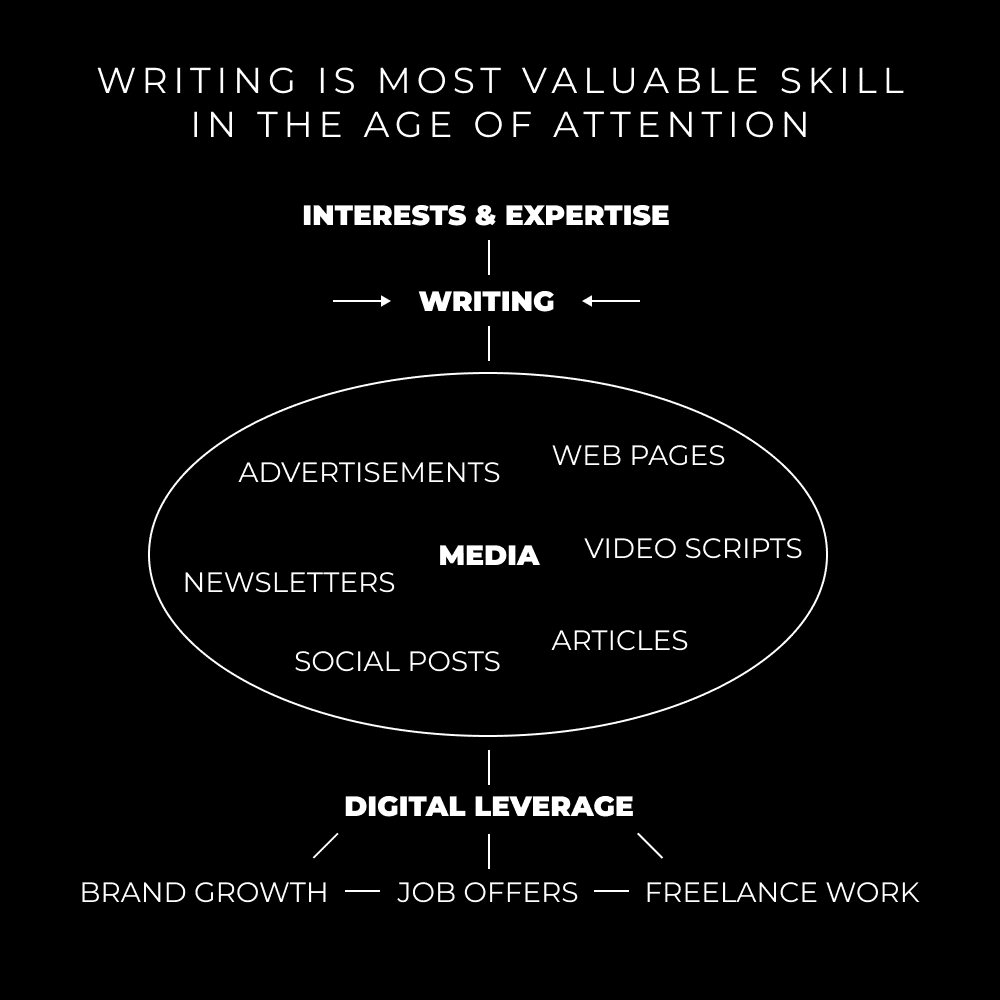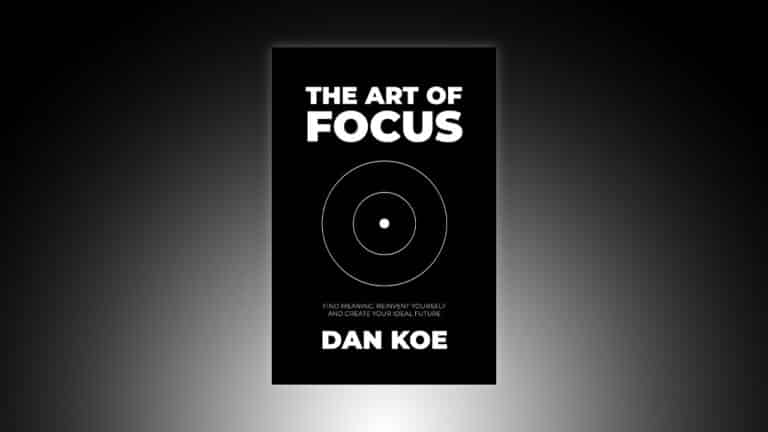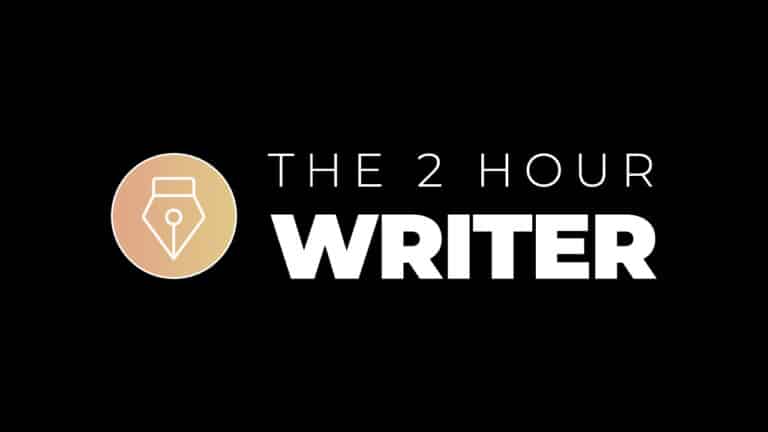Ever since I can remember, I’ve had the goal of doing what I love for a living. Isn’t that what everyone wants?
My family, teachers, and even the people I was following online screamed at me to go down other paths.
So that’s what I did.
- Went to college and partied the entire time
- Learned creative skills on the side
- Started every online business imaginable
- Learned to code because it was “lucrative”
- Dropped out of college because it was wasting my time
- Got a $55K/year job as an entry level web developer at a design agency
Throughout this entire journey, my dream of “doing what I love” stuck in the back of my head. I was constantly reminded of it. There wasn’t a single moment from age 16-25 where I wasn’t working on a meaningful side project.
I still maintain this habit to this day. If it isn’t a business project, its a health project. This is how I get out of a rut, because the only reason I fall into a rut is psychic entropy, the mind tending toward disorder. Meaning I don’t have a goal, project, or priority to bring my focus to. When I spend time contemplating an area I want to make progress in, a vision will pop into my head after some time. The result? A dramatic boost in my quality of life. IF I act on that vision immediately.
My current projects are my new writing product and getting my compound lifts back up in the gym after an extended break from them. I really want to hit a 600 pound deadlift for some reason, even when I swore off of them a few years ago. It just sounds fun, risk aside (and risk adding to the fun and necessity of maintaining healthy habits).
Why am I telling you this?
Because I realized that nobody knew what they were talking about. I was taking career and life advice from people that hadn’t achieved what I wanted to achieve. In their closed mind the reality I wanted to create was impossible, yet I kept looping back to projects that I loved working on for the sake of maintaining my sanity.
Meaning, if I could find a way to monetize these “passion projects” then I would be set.
After years of trial and error with every “marketable skill” that people tell you to learn, I found the secret.
Why Writing?
The backend of the internet is code. The frontend of the internet is media. If you want to thrive in the future, mastering code or media is your best bet. If you can master — or build a team — to take advantage of both (like marketing a software company) you shouldn’t have any worries about your life direction.
That is, being able to leverage both media and code. Which is more than possible with no-code tools like website builders, membership dashboards, email sending platforms, and other software that makes the one-person business model possible.
Do you not see the power in this? Does this not fuel you with immense energy to learn anything and everything available to you? Why have you not started failing at building a business when you can leverage code and learn media to build your mini-empire while spreading a message that you love spreading?
I learned to code in college, but I didn’t care for becoming a programmer. I wanted to freelance. So that’s what I tried to do. Web design, SEO, Facebook ads, content marketing, digital art, and every other skill under the sun… except for one.
There was a reason I failed at all of these business models. I didn’t understand what people actually wanted to buy. Not only that, I didn’t know how to get them to buy what I had to offer. That’s when I found Twitter. People were talking about online business and self-improvement. I got sucked in.
Some accounts that were posting insights about eCommerce mentioned a skill called “copywriting.” When I studied it deeper, that seemed to be the piece I was missing. Copywriting, in my definition, is persuasive writing. Think marketing and sales — two of the most important skills for making an income — but in written form.
As you could guess, this was the missing piece to my success. I started writing on Twitter to practice my writing, learned from my failures, and built a cumulative 350K follower audience across multiple platforms.
Again, Why Writing?
Media is the frontend of the internet. It’s how you capture, hold, and convert attention in a sea of self-deprecating memes and valueless content.

The foundation of media is writing.
- Tweets? Writing.
- Threads? Writing.
- Newsletters? Writing.
- Blog posts? Writing.
- Cold emails? Writing.
- Ads of any form? Starts with writing.
- YouTube videos? Done best with written scripts.
- Instagram reels and TikToks? Like reading well-written tweets.
- Images on Instagram? Usually designed from a well-written quote or saying.
- Any other form of online marketing, advertising, or entertainment? Starts with writing.
There’s a reason I can outperform every dude with six pack abs in terms of engagement and follower growth on Instagram.
High-impact digital writing.
If you want to become a master of media (and leverage no-code tools to distribute your writing and attract an audience) it’s pretty clear that writing needs to be the foundation of your one-person business.
Before we dive in: Pre-sale for the 2 Hour Writer is now live. If you are an aspiring writer, one person business owner, or content creator that wants to implement my content ecosystem — you can get 40% off here until the launch date.
9 Steps To Starting A One-Person Writing Business
I call myself a writer because that is what I do on a daily basis (even when it doesn’t seem like it on social media).
I’ve sustained a $40-$60,000 per month income by writing tweets, newsletters, and threads that get repurposed into Instagram posts, YouTube videos, LinkedIn posts, and the rest.
In reflection, and referring to the top of this letter, writing is the force multiplier that helped me make my previous salary month after month.
But, if you were to strip things down to only Twitter and a Newsletter, I would still maintain 85-90% of my income. I don’t promote often, if at all, on other platforms. I’m building leverage and cross platform authority for now.
Getting into it, here are the 9 steps to start your writing business.
1) Choose A Topic You Can’t Shut Up About
Choosing a topic is what everyone struggles with in content creation. Let me make it simple for you.
Write down:
- Your favorite books
- Your recent YouTube watch history
- Your favorite social media accounts
- What you would write about if money wasn’t an issue
Seriously, pull out a piece of paper (or the notes app in your phone) and write down these all down.
Why are we doing this?
Because good writing isn’t about being professional. It’s about energy transfer. You will be excited to sit down and write everyday and that energy will show in your writing.
2) Brainstorm A Unique Perspective You Have
Novelty catches attention. Attention is a given if you want people to read what you write.
Novel perspectives are the best (and replicable way) to capture attention.
How do you come up with a novel perspective?
Braindump:
- Common problems associated with the topic
- Benefits to overcoming those problems
- Common goals associated with the topic
- Roadblocks to achieving those goals
- Personal experiences you’ve had
Now, piece everything together and explain it how you would if you were talking to a friend.
Don’t try to copy someones perspective or way of wording things. Say it in your own voice and let it refine with time, effort, and practice.
If you want a guided challenge on how to do this, download my free 7 days to genius challenge.
If you don’t want to go through that, you can practice explaining topics in your own words and let experience create your perspective. You can do this by writing tweets everyday for a year. See what you can learn.
3) Write 1000+ Words On The Topic
Every single piece of content online is based around a personal or professional problem.
Here’s how you can structure your writing.
- Explain the problem associated with the topic
- Talk about your personal experiences with it
- Optional: give context around the problem
- Give step-by-step actionable advice on how to solve that problem (like this letter)
Actionable advice is how you will build an audience at the start. I wouldn’t worry about being super insightful, that won’t help you grow until people know who you are.
Like how your favorite YouTuber didn’t start with vlogs. They started with what works, built an audience, then desaturated that market by doing whatever they want. Meaning that you can join in at anytime (this doesn’t only pertain to YouTube).
4) Sign Up For A Blog & Newsletter Software
I rarely use fancy sales funnels and it’s rare to see me promote my products on social media anymore.
I use the 2 hour content ecosystem:
- 1 newsletter a week
- The newsletter is kept on the blog
- 1 thread a week from the newsletter
- 3 tweets a day from the newsletter topic
People that only tweet have little authority and have trouble making sales and landing clients.
Authority comes from 1 of 2 things: depth or expertise.
Long form content is where the money is made. Not with tweets and social media promotions.
For the sake of simplicity, I would sign up for Beehiiv, Revue, or Substack. We aren’t looking for fancy automations yet. All we want is a software that can send a newsletter, collect emails, and backlog that newsletter as a blog post (crucial point that no-one takes advantage of) so we can plug those as mini-salesmen or individual lead magnets under our other content.
5) Repurpose The Actionable Section Of The Newsletter
We know that actionable step-by-step advice is the most beginner friendly and potent tool for social growth. If you don’t know how to grow, chances are that you are trying to be too clever and insightful from the start — when all you need to do is give actionable advice related to your talking point (and pair it with step 6 of this newsletter).
Pair actionable advice with a Twitter thread and you have the potential to gain 100-1000 followers your first time around. I see this happen all the time.
How do we make this easy?
Turn the actionable section of the newsletter you wrote into a Twitter thread. Simple as that. I show you exactly how in my new course, 2 Hour Writer, to make sure that it is written for maximum impact.
6) Learn How To Network & Grow On The Platform
When you start playing a game, you don’t just dive in and start playing. You’ll have no idea what you are doing, get angry, and quit.
The reason you’ve tried and failed at growing on different social platforms is because you think it is as simple as posting good content. Not in the slightest.
You grow on social media platforms by getting more eyes on your profile. How do you do that?
- People sharing your content to their audience
- Networking with similar follower accounts and growing together
- Commenting on larger accounts posts so people can see your comments and click to your account
- Make your long form content (newsletter) so good that people can’t help but talk about it
- Join a community (like Modern Mastery) to meet people that are on the same path as you.
- Optional but less taboo than you think: paying big accounts for shares (retweets, story shares on Instagram, or even something as simple as a comment because that still exposes your content to their audience).
Of course, you still need to have good content and an optimized profile if you want people to follow you.
It’s called social media for a reason. You have to interact with others, make friends, and help each other grow.
You can do without this, but it will be painstakingly slow and you’ll turn into one of those accounts that just whines all day about how social growth is unfair. Don’t hate the player, hate the game.
7) Turn Ideas Into Impactful Tweets
From your newsletters and threads, your mind should be flooded with tweet ideas. Tweets are short and punchy writing that get people to react.
My favorite way of writing tweets is with the framework I developed: PPP
- Pull
- Perspective
- Punchline
Pull them in with something that catches attention (like a number or percentage), give a unique perspective that came from personal experience and critical thought, and wrap it all up in a way that makes sense.
Perspective and punchline often tie into one another, usually in one-liners like this:
People will spend 10 hours worrying about a task that takes 10 minutes to complete.
— DAN KOE (@thedankoe) August 8, 2022
You can also see this framework separated well in list tweets (use these when you give actionable advice):
Most people will spend:
— DAN KOE (@thedankoe) August 8, 2022
8 hours on someone else’s dreams
4 hours hiding from their own
2 hours going through the motions
16 hours awake
24 hours asleep
It doesn’t have to take 40 years and a retirement plan realize that a participation trophy isn’t fulfilling.
This is one of many tweet writing methods. Your best bet is to study the accounts you listed in step 1 and follow the Intelligent Imitation process. Emulate their writing as if their tweets were training wheels, dissect why it did well, and try to replicate in your own way.
8) Develop A Writing System
This newsletter goes over everything I would do if I had to start over from zero.
I wasted 2 years testing sales funnels, different content writing methods, and finding the best way to sustain a high monthly income with writing.
My best advice?
Create a system from the start and refine it over time. Then, if you want to package it up and sell it in the future, you can. That’s what the one-person business model does. They get results with a system they’ve tested on themselves (to solve their own problem) and then sell it to others — because by the time the system is perfected, you have ample experience and authority to bank on.
I use Notion to create systems to make it easy on myself. No other fancy software necessary.
These systems can start as step-by-step list of what you need to do on a daily or weekly basis. Then you can start getting fancy with Notions cool features.
9) Branch Out To Other Platforms
I overcomplicated this for the longest time.
I’ve grown to 230K on Instagram, 23K on LinkedIn, and 7K on YouTube with my writing skills.
I get more engagement than dudes with adonis physiques because my writing hits harder than their chiseled abs.
All I do is copy, paste, and record the content that I’ve already written in my newsletters, threads, and tweets. You could even turn your best tweets into TikTok or reel scripts.
Master Twitter first, gain some authority, then use your best tweets to break into new platforms (since those ideas are already validated to do well).
Let’s Recap On How You Can Start Your Writing Business
With 1-2 hours a day (considering you have a freelance, consulting, or digital product to sell with the traffic / distribution you are building) you can pull in a higher monthly income than some of the highest paid doctors, without spending a dime on a college degree.
We live in an age of authenticity where nobody is authentic. People don’t want professionalism. They want individuality and a sense of belonging with people that “get them.”
I am nowhere near the best writer, yet I make more than 99% of the writers out there. Funny how that works.
Here’s a recap of what we went over:
- Choose a topic you can’t shut up about
- Brainstorm a unique perspective you have
- Write 1000+ words in a structured way
- Sign up for a newsletter / blog software and post it
- Turn the actionable section into a viral Twitter thread
- Learn how to network and get eyes on your content
- Turn ideas from your newsletter into tweets and plug your newsletter under it to “read more” (this will grow your email list)
- Develop a system to make writing take less than 4-6 hours a week
- Branch out to other platforms when you are ready
Lastly, if you have a product or service, you wouldn’t promote it on the timeline.
That’s the beauty in this content ecosystem. You build authority with depth in your newsletters, post them as blogs, and plug your offer there.
Now, you plug relevant newsletters under your tweets and threads everyday. No salesy promotions, no spamming on the timeline. Just perfected social media growth and more sales than any 10 step sales funnel you could build (I’ve tested).
The 2 Hour Writer Is Live!
If you are a creative or one-person business that wants to:
- Implement the 2 hour content ecosystem for social growth and authority
- Generate unlimited viral content ideas without templates
- Learn to write in their own unique voice and make their ideas interesting enough to share
Then check out everything else that is included in the 2 Hour Writer here.
Hope to see you inside!
— Dan “you don’t need an english degree to type words on the internet” Koe





